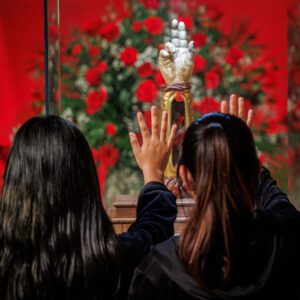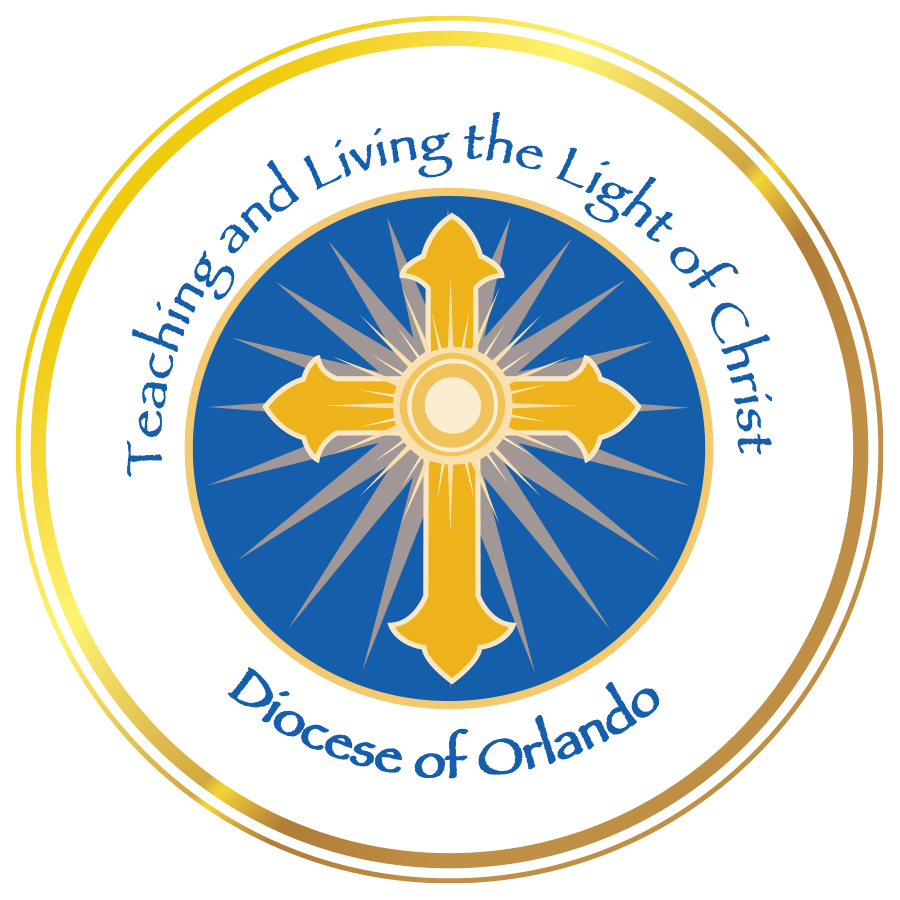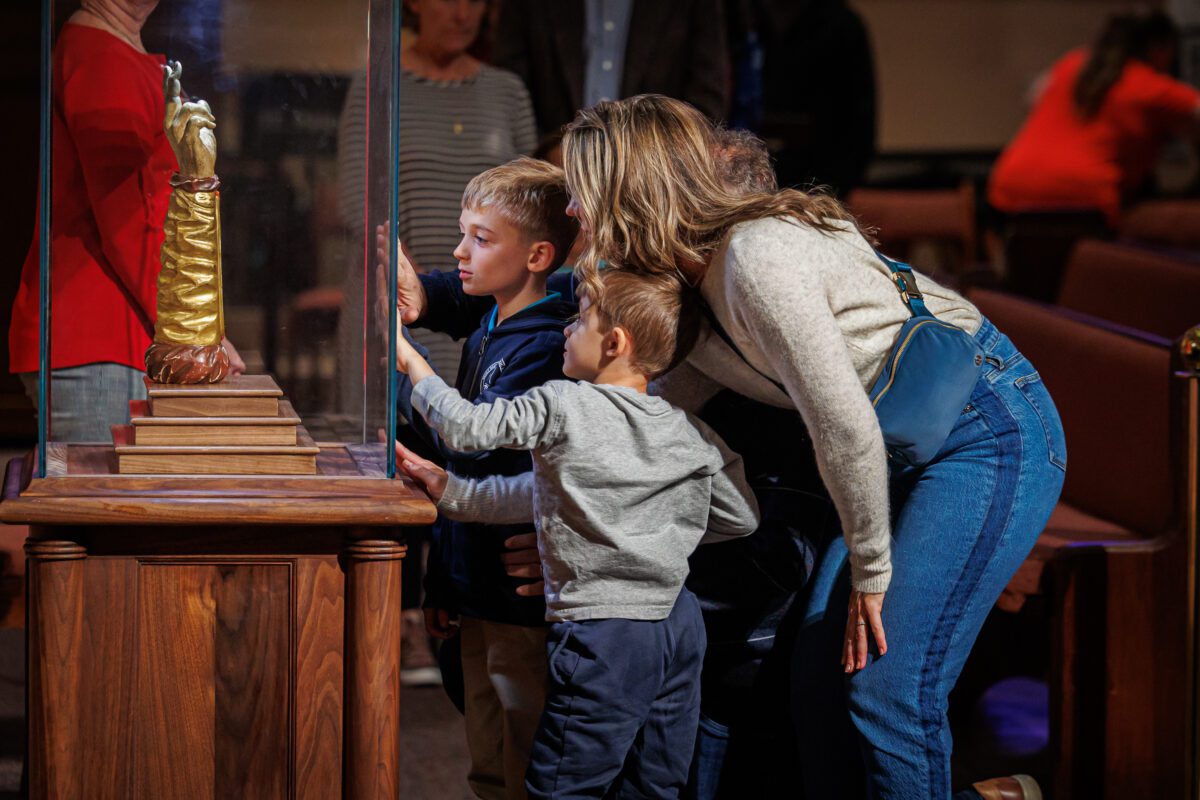DAYTONA BEACH | At its largest gathering in its 143-year history, thousands came to honor the Lord in Mass and venerate the relic of St. Jude at the Basilica of St. Paul, Feb. 23. The basilica was one of more than 100 stops on the Arm of St. Jude: The Apostle of the Impossible national tour and one of seven stops in Florida churches. The tour title is a reference to St. Jude’s ability to aid in desperate and hopeless causes.
One of the twelve apostles called by Jesus, St. Jude (Also known as Thaddeus) was a first cousin of Jesus, the son of Mary of Clopas – a relative of Mary’s who sat at the foot of the cross with her, according to the Fathers of the Church and the ancient historian Eusebius.
“It is very humbling, but a privilege and an honor,” said Father Ken Gill, rector of the basilica, referring to the opportunity to host a relic of the great saint. Having received news of the basilica’s selection as a host to the relic just after celebrating Mass on the feast day of St. Paul, Father Gill considers the basilica’s participation as God’s will stating “there are no coincidences in the spiritual life.”
To prepare, the basilica installed high-definition cameras to livestream the Mass, enabling more than 500 people to participate online.
A choir composed of roughly 40 voices from parishes around the diocese joined in song, a reflection of the communal love and veneration of St. Jude. The once in a lifetime opportunity came with a plenary indulgence offered by the Holy See for those who venerate the relic and fulfill the ordinary requirements.
“Our saints are our friends, and for a lot of people, St. Jude is one of the greatest devotions they have,” said Father Gill. “Wherever you go around the world – Catholics and non-Catholics – people know St. Jude.” He noted people often pray to St. Jude when in difficult circumstances and situations. “In many ways, I hope this is an opportunity for people to be reinvigorated in their faith and trust in Jesus Christ, and to renew a friendship with a saint.”
Father Gill was pleased the relic would allow another way for the basilica to fulfill its mandate to be an ideal center of special liturgical and pastoral ministry in the Diocese of Orlando. “We feel like this is kind of renewing us as well and the expectation of how we should be Church in this part of the region,” he said.
The community’s response speaks to the success of that endeavor. People from throughout the diocese came to venerate the Arm of St. Jude. Daniel, a parishioner from Most Precious Blood Parish in Oviedo, drove more than an hour with his young son to pay homage to his father’s patron saint. Another elderly parishioner of the basilica came in his wheelchair. “I’m here in honor of my mom. St. Jude was her patron saint. She believed in him,” he said.
One woman brought a photo of her grandson and that of her and her husband on their wedding day. She prays her grandson will be baptized and her marriage continues to be blessed.
The Williams family, parishioners of Sacred Heart Parish in New Smyrna Beach wanted to “pray for all the souls who seem to have lost their way.”
Some, like Bryson Gregory came upon the exposition of the relic accidentally. A faithful devotee of St. Jude, he sought religious articles related to the saint and found the sign announcing the opportunity to venerate him. Working down the street, he arrived just one hour after it opened.
“I came here because I need help,” said another young man from the basilica. “There’s a lot going on in my life right now, for good and for bad. So, I’m praying as much as I can. And more can’t hurt.”
The relic arrived at the basilica early Friday afternoon, brought by Companions of the Cross Father Carlos Martins, church custodian of the relic and director of Treasures of the Church. Treasures of the Church’s mission, in partnership with the Holy See, is “to evangelize by giving people an experience of the living God through an encounter with the relics of his saints in the form of an exposition.”
Father Martins noted what was particularly unusual about this relic is that it comes from someone who often embraced Jesus as an apostle and as family.
In an interview with Florida Catholic, Father Martins hoped to provide more clarity and answer some frequently asked questions about saints and relics.

Although the Arm of St. Jude is considered a first-class relic Father Martins said, “Nowhere in any Church document are relics divided into classes. Those are ‘street terms’. So, a part of the body of the saint, something the saint touched or something that has been touched on to another relic of a saint – the Church just calls those relics.”
Father Martins also explained why it is acceptable to distribute the body of a saint, but the faithful should not spread their own ashes.
“Every human culture from the beginning of time has practiced burial of the dead. The dead have never been abandoned. It is written within the human fabric, the human consciousness, that there is a duty to take care of the dead. That’s called the natural law, threaded into our being. We don’t have to learn it. It’s there.”
He explained, this act of honoring the saints through relics is biblically grounded, citing the book of 2 Kings which describes the corpse of a man which touched the bones of the prophet Elisha, and the man came back to life. Matthew further tells of the woman’s hemorrhaging which stopped after touching the hem of Jesus’ garment.
“Joseph made the Jews promise to carry his bones out of Egypt,” said Father Martins. “What they’re doing there is carrying the relics of a saint.” He noted the Jewish people often wanted to be buried near holy persons.
Finally, he spoke of the veneration of the bones of Polycarp, the apostle John’s disciple who was converted, baptized and ordained a bishop. John lived when Polycarp was martyred. In The Acts of St. Polycarp, his disciples tell of collecting his relics, then gathering once a year to celebrate the Eucharist over his tomb.
“God Himself has manifested the desire for this through His Church and, specifically, through the healings that are accomplished through the veneration of relics,” said Father Martins. “Our job is to follow the plan of God, not to alter it. The saints have a right to veneration and that right supersedes their rite to an intact burial.
To learn more, please visit here.
To view the livestream of Mass, click here.
By Glenda Meekins of the Florida Catholic staff, February 29, 2024

